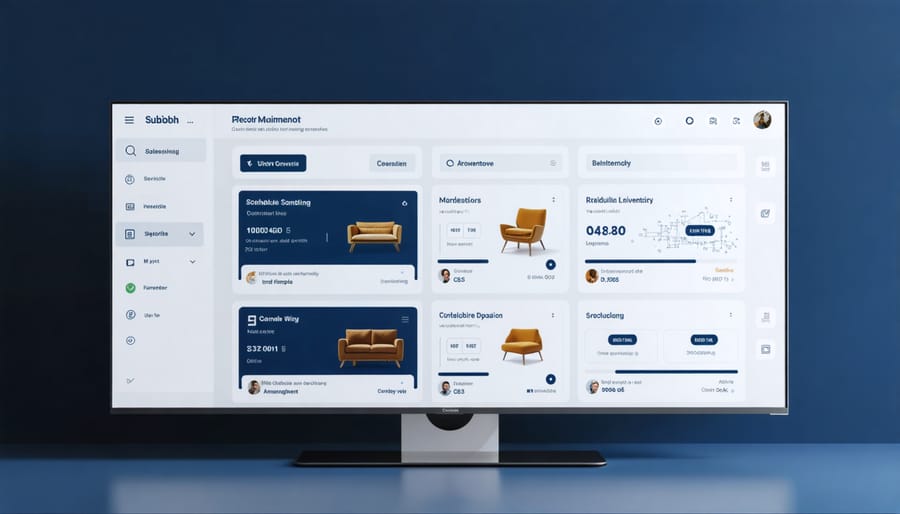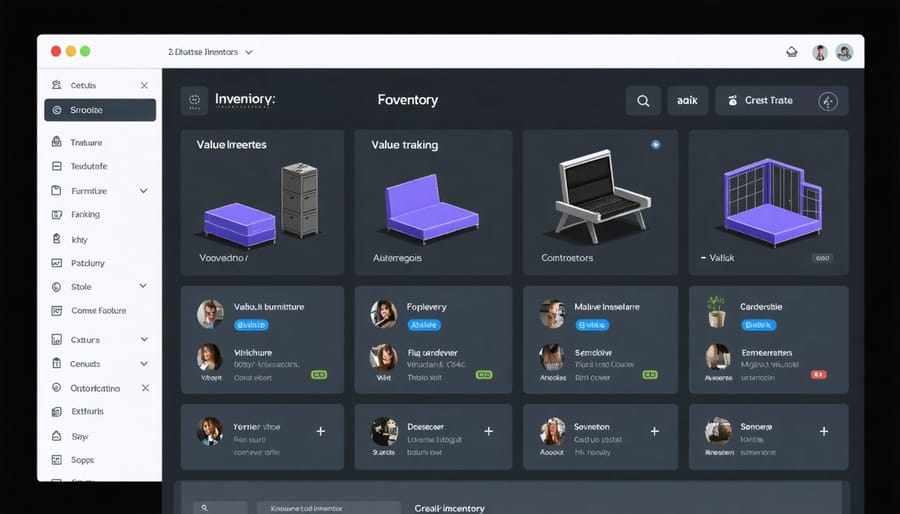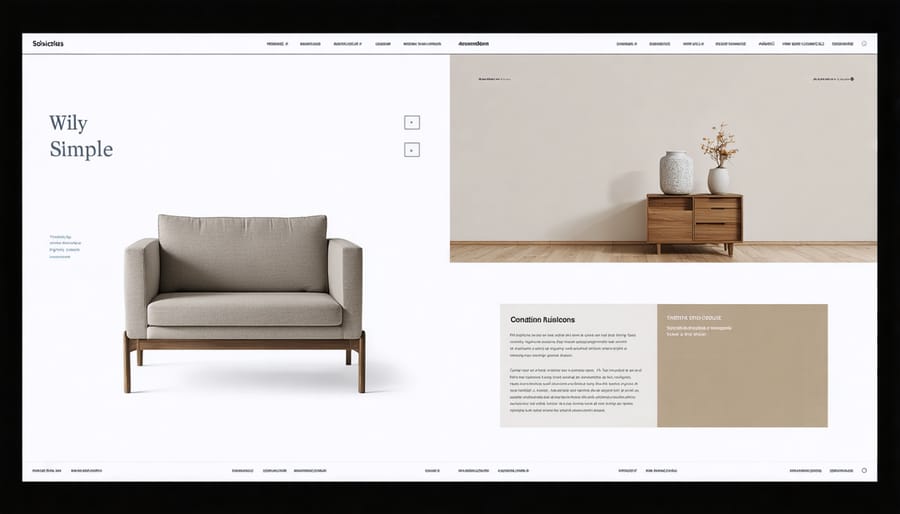
Transform your asset management operations with cloud-based solutions that eliminate manual tracking headaches and provide real-time visibility across your entire inventory. Today’s property managers face unprecedented challenges in tracking valuable assets, from office furniture to maintenance equipment, across multiple locations. Cloud-based asset management software delivers the perfect solution by centralizing control, automating workflows, and providing instant access to critical data from any device.
Modern cloud platforms revolutionize how businesses handle their physical assets through powerful features like QR code scanning, automated maintenance schedules, and comprehensive reporting dashboards. Whether you’re managing a small furniture collection or overseeing multiple commercial properties, these systems adapt to your specific needs while maintaining bank-grade security standards.
By shifting asset management to the cloud, organizations typically reduce tracking errors by 87% and cut administrative costs by up to 35%. The ability to access real-time inventory data, maintenance histories, and location tracking from anywhere has become non-negotiable in today’s fast-paced business environment. Leading companies leverage these platforms to make data-driven decisions, optimize asset utilization, and ensure compliance with regulatory requirements.
Cloud-based asset management revolutionizes how businesses track their furniture collections through sophisticated digital inventory management systems. Unlike traditional paper-based methods, cloud solutions provide instant, real-time updates accessible from any device with an internet connection.
Property managers can now monitor their furniture assets with unprecedented accuracy. Each piece can be tagged with unique identifiers, allowing for immediate location tracking, condition updates, and maintenance scheduling. When a chair needs repair or a table is relocated to a different room, the system updates automatically, ensuring all stakeholders have access to the latest information.
The real-time nature of cloud tracking also enhances decision-making capabilities. Managers can quickly identify underutilized pieces, track wear patterns, and forecast replacement needs. This proactive approach helps prevent inventory shortages while optimizing furniture distribution across properties.
For insurance purposes, the system maintains detailed records of each item’s condition, complete with time-stamped photos and maintenance history. This documentation proves invaluable during claims processing or when planning restoration work.

Cloud-based asset management software revolutionizes maintenance planning by leveraging predictive analytics and real-time monitoring. The system tracks usage patterns, wear indicators, and maintenance history to create intelligent scheduling that prevents costly repairs. Through automated notifications, property managers receive timely alerts when furniture pieces require attention or when specific furniture restoration techniques need to be applied.
The software’s scheduling features eliminate the guesswork from maintenance planning by automatically generating work orders based on manufacturer recommendations and historical data. This proactive approach helps extend furniture life spans while reducing unexpected breakdowns. Property managers can easily view upcoming maintenance tasks, assign work to specific team members, and track completion status through user-friendly dashboards.
Additionally, the system maintains detailed records of all restoration work, including before-and-after documentation, materials used, and costs incurred. This comprehensive tracking enables better budget planning and helps identify patterns that might indicate broader maintenance issues. By centralizing this information in the cloud, teams can access critical maintenance data anywhere, ensuring consistent care across multiple locations.
Digital documentation capabilities transform how you manage and monitor your furniture assets. With cloud-based solutions, you can capture high-resolution photos, detailed condition reports, and maintenance records directly through your mobile device. These visual records create a comprehensive digital timeline of each piece, making it easier to track changes, document damage, and plan restoration work.
The software typically includes features for annotating photos, highlighting specific areas of concern, and adding detailed notes about condition, repairs, or maintenance needs. This visual documentation proves invaluable for insurance claims, warranty records, and maintaining accurate asset valuations.
Property managers particularly benefit from the ability to conduct digital walk-throughs, instantly uploading photos and notes to the cloud where they’re immediately accessible to all authorized team members. The system automatically organizes and tags images, making it simple to retrieve specific documentation when needed.
Many platforms also offer side-by-side comparison features, allowing you to track item conditions over time and demonstrate the effectiveness of maintenance or restoration work through before-and-after galleries.

Cloud-based asset management software revolutionizes how businesses track and protect their furniture investments through sophisticated value monitoring and insurance management features. The system automatically updates furniture valuations based on market trends, depreciation rates, and condition assessments, ensuring accurate insurance coverage at all times.
Property managers can set up automatic alerts for insurance renewal dates and coverage thresholds, preventing costly lapses in protection. The software maintains detailed records of each piece’s purchase price, current market value, and replacement cost, making insurance claims processes significantly more streamlined.
Real-time value tracking becomes particularly valuable during market fluctuations or when dealing with antique or specialty furniture pieces. The system can generate comprehensive reports for insurance providers, complete with condition photographs, maintenance records, and value appreciation or depreciation trends.
Many platforms integrate directly with insurance providers, enabling automatic updates to coverage levels as asset values change. This dynamic approach ensures that furniture collections remain properly insured without manual intervention. Users can also configure custom valuation rules based on specific categories, locations, or usage patterns, providing a tailored approach to value monitoring that aligns with their unique needs.
Cloud-based asset management software revolutionizes how businesses track and schedule furniture maintenance through comprehensive repair history logging and automated scheduling features. Property managers can easily document every repair incident, including detailed notes, photos, and furniture repair advice received, creating a valuable historical record for each piece.
The system automatically generates maintenance schedules based on manufacturer recommendations, usage patterns, and previous repair data. Users receive timely notifications for upcoming maintenance needs, helping prevent costly emergency repairs and extending furniture lifespan. This proactive approach ensures regular upkeep while minimizing disruption to business operations.
Service history tracking includes important details such as repair costs, technician notes, and parts replaced, providing valuable insights for budgeting and future maintenance planning. The software also maintains warranty information and service provider contacts, streamlining the process when repairs are needed.
For multi-location businesses, the cloud-based platform enables standardized maintenance protocols across all properties while allowing local managers to schedule and oversee repairs. This centralized approach ensures consistent quality control while maintaining flexibility for individual location needs. Real-time reporting features help identify trends in furniture maintenance, enabling better decision-making for future purchases and preventive care strategies.
Getting started with cloud-based asset management for your furniture collection is a straightforward process that begins with careful planning. First, conduct a thorough inventory of your existing furniture pieces, documenting essential details like item descriptions, conditions, and locations. Take clear photographs of each piece to establish baseline records.
Next, select a cloud-based asset management platform that suits your needs. Consider factors such as user interface simplicity, mobile accessibility, and integration capabilities with your existing systems. Many platforms offer free trials, which can help you make an informed decision.
Once you’ve chosen your platform, start by uploading your inventory data. Create a consistent naming convention for your assets and organize them into logical categories. Include important details such as purchase dates, warranty information, and maintenance schedules.
Set up user accounts and access permissions for team members who need to interact with the system. Provide basic training on essential features like adding new items, updating records, and generating reports.
Implement a tagging system using QR codes or barcodes for easy identification and tracking. Attach these tags to your furniture pieces in discreet but accessible locations. This step enables quick scanning and updating of asset information using mobile devices.
Finally, establish regular maintenance schedules and set up automated notifications for important dates and tasks. This proactive approach helps ensure proper care and longevity of your furniture collection while maximizing the benefits of your cloud-based system.
To maximize the effectiveness of your cloud-based asset management software, start by establishing clear naming conventions and organizational hierarchies for your furniture assets. Ensure all team members are properly trained on the system, with regular refresher sessions to maintain consistency in data entry and management practices.
Implement a robust tagging system that includes essential details like purchase dates, maintenance history, and location information. Take advantage of mobile capabilities by encouraging staff to update asset information in real-time using smartphones or tablets, which helps maintain accurate inventory records.
Regular data backups and periodic system audits are crucial for maintaining data integrity. Schedule monthly reviews of your asset database to identify and correct any inconsistencies or outdated information. Enable automated notifications for maintenance schedules and warranty expiration dates to stay proactive with furniture care.
Customize dashboard views for different user roles to streamline workflows and improve efficiency. Property managers might need comprehensive overview reports, while maintenance staff may require detailed repair histories and scheduled maintenance tasks.
Make use of the software’s analytical tools to track trends in furniture maintenance costs, identify frequently damaged items, and make informed decisions about future purchases. Document successful processes and share best practices across your team to ensure consistent implementation of the system.
Remember to regularly update the software to access new features and security improvements, and maintain open communication channels with your software provider for technical support and optimization suggestions.

In today’s digital landscape, protecting your furniture asset data is as crucial as securing physical inventory. Cloud-based asset management software employs multiple layers of security to safeguard your valuable information. Leading platforms utilize bank-grade encryption protocols and secure socket layer (SSL) technology to protect data both during transmission and storage.
To maintain data integrity, these systems implement smart cybersecurity measures such as two-factor authentication, regular security audits, and automated backup systems. Your furniture inventory data is stored across multiple secure servers, ensuring business continuity even in unexpected circumstances.
Access control features allow you to set specific permissions for different team members, ensuring that sensitive information is only available to authorized personnel. This granular control helps prevent unauthorized modifications while maintaining transparency in operations.
Most reputable cloud-based solutions comply with international data protection standards like GDPR and maintain SOC 2 certification, demonstrating their commitment to data security. Regular system updates address emerging security threats, keeping your asset management system protected against new vulnerabilities.
Data recovery and backup procedures are automated and scheduled regularly, protecting against data loss due to human error or system issues. Your furniture asset information is typically backed up in real-time across multiple geographic locations, providing peace of mind and ensuring business continuity.
For added protection, look for platforms that offer audit trails, recording who accessed what information and when, helping you maintain accountability and trace any unauthorized activities.
Cloud-based asset management software represents a transformative solution for modern furniture and property management. By embracing these digital tools, businesses can significantly streamline their operations, reduce costs, and make more informed decisions about their assets. The ability to access real-time data from anywhere, collaborate seamlessly with team members, and maintain accurate records has proven invaluable for organizations of all sizes.
The benefits are clear: enhanced security through regular backups and encryption, improved efficiency through automated workflows, and better financial planning through detailed reporting and analytics. Property managers and business owners who have made the switch consistently report higher productivity, fewer lost or misplaced assets, and better maintenance scheduling.
As we move further into the digital age, adopting cloud-based asset management software isn’t just an option – it’s becoming a necessity for staying competitive. Whether you manage a small collection of premium furniture or oversee multiple property locations, these solutions offer the scalability and flexibility needed to grow your business confidently.
Consider taking the first step toward modernizing your asset management approach. The investment in cloud-based solutions today will pay dividends in operational excellence and peace of mind tomorrow.